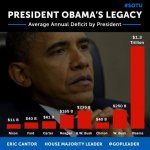https://www.mypalmbeachpost.com/new...-equal-obama-deficits/pPcoiUJYo0IauvpaQrXumL/White House figures show Trump on pace to equal Obama deficits
Despite clear signs of expanded economic growth, the latest White House budget estimates predict that President Donald Trump is on the verge of overseeing an expansion of federal deficits which will rival that of President Barack Obama’s two terms in office, as the Trump Administration now forecasts a deficit next year that will be over $1 trillion, with no signs of a balanced budget on the horizon.
The latest figures issued by the Office of Management and Budget now predict a deficit this year of $890 billion – and deficits of over $1 trillion per year in 2019, 2020 and 2021.
When you take the $665 billion deficit from Fiscal Year 2017 – Mr. Trump’s first year in office – and then add the projected deficits from the White House budget office for seven more years – you get $7.3 trillion in debt for what would equal two terms of a Trump Administration.
That would be almost identical to the $7.28 trillion in deficits run up under the eight years of the Obama Administration.

The deficit under Trump will jump $420B a year from 2017-2019 according to the White House's new OMB projections.
To put that in perspective, that delta is roughly equal to 2X the spending in the Affordable Care Act.
It's a 63% increase in yearly red ink.
— Steven Dennis (@StevenTDennis) July 18, 2018
The deficit for 2018 is already running at $607 billion, not far from the 2017 total of $665 billion; one reason for the increase this year is fairly straightforward according to figures from the Treasury Department – revenues coming in to Uncle Sam are down since the implementation of the tax cut plan earlier this year, and overall government spending is up.
The update in budget deficit estimates earlier this month by the White House drew almost no attention on Capitol Hill, where GOP demands for budget restraint have for the most part, gone silent.
The last time the budget was close to being balanced was 2007, when the deficit dropped to $161 billion. But in 2008, the Wall Street Collapse led to an extended recession, as deficits jumped to $458 billion in 2008, and $1.41 trillion in 2009.
A few weeks ago, White House economic adviser Larry Kudlow boldly pronounced in a television interview that the federal deficit was coming down, because of a jump in revenues spurred by economic growth under the Trump tax cuts.
But figures clearly show, that just is not the case, as the budget estimates for the White House show flat revenues in 2018, when compared to a year earlier
@larry_kudlow: "The deficit… is coming down, and it's coming down rapidly. Growth solves a lot of problems." pic.twitter.com/H375h7rV0a
— FOX Business (@FoxBusiness) June 29, 2018
“The White House is living in an alternate economic universe,” says Maya MacGuiness, the head of the Committee for a Responsible Federal Budget.
But few in Washington seem to be listening to warnings from budget watchdog groups like the CFRB, as the deficit just keeps going up, generating little consternation among GOP lawmakers in Congress who once badgered the Obama Administration about its deficit spending.
https://www.vox.com/business-and-fi...78/trump-tax-reform-bill-2018-maria-bartiromo
Trump is already talking about another tax bill
He might want to take a look at the polling on the first one.
The Republican tax cuts aren’t even a year old, nor are they particularly popular with voters. And already, President Donald Trump is talking about more of them.
In an interview with Fox News aired on Sunday, Trump promised a second tax cut plan would be on the way by October. He said the proposal would be aimed at the middle class — then offered an example of reducing the corporate tax rate further.
Here’s what Trump said in the interview with Fox Business host Maria Bartiromo:
We’re doing a phase two. We’ll be doing it probably in October, maybe a little sooner than that. And it will be more of a middle class — we did a lot for the middle class, but this will be more aimed at the middle class.
One of the things we’re thinking about bringing the 21 percent [tax rate for corporations] down to 20. And then, for the most part, the rest of it would go to the middle class. It is a great stimulus.
Beyond the promise to reduce the corporate rate — which December’s tax bill already cut to 21 percent from 35 percent — Trump didn’t offer specifics on what this new potential legislation might do. Damian Paletta at the Washington Post pointed out that Republicans have floated the idea of making the tax cuts passed last year for families and individuals permanent. Right now, they expire in 2025.
The GOP bill cut taxes for most Americans, including the middle class, but it heavily benefits the wealthy and corporations. According to estimates from the Center on Budget and Policy Priorities, the top fifth of earners get 70 percent of the bill’s benefits, and the top 1 percent get 34 percent. The new tax treatment for “pass-through” entities — companies organized as sole proprietorships, partnerships, LLCs, or S corporations — will mean an estimated $17 billion in tax savings for millionaires in 2018. American corporations are showering their shareholders with stock buybacks this year, thanks in part to their tax savings.
If Trump thinks another tax cut will be a winning issue in the midterms, he might want to take a look at the polls.
Trump is holding out the prospect of another tax bill as the 2018 midterm elections approach, perhaps believing the issue will help Republicans win. But voters haven’t been particularly impressed with 2017’s $1.5 trillion cuts.
In February, a Politico-Morning Consult poll found that most Americans weren’t noticing a tax cut in their paychecks.
A Monmouth University poll from June found that the GOP’s tax bill is actually becoming less popular, with 34 percent of Americans saying they approve of it while 41 percent disapprove. That’s down from the same poll in January, when 44 percent of Americans said they approved of the bill and 44 percent did not.
Republicans have struggled to sell the tax cuts to voters now that they’ve passed. (Remember Paul Ryan’s tweet bragging about the public school employee seeing another $1.50 in her paycheck?) They appear to be turning to other messages — particularly, immigration — to motivate voters.
But it looks like Trump doesn’t need to be sold on the tax cuts, or a second round of them. Corporations probably wouldn’t need much convincing either: The Post estimates that an additional 1 percent decrease to the corporate tax rate would result in an additional $100 billion in tax cuts over the next decade.


